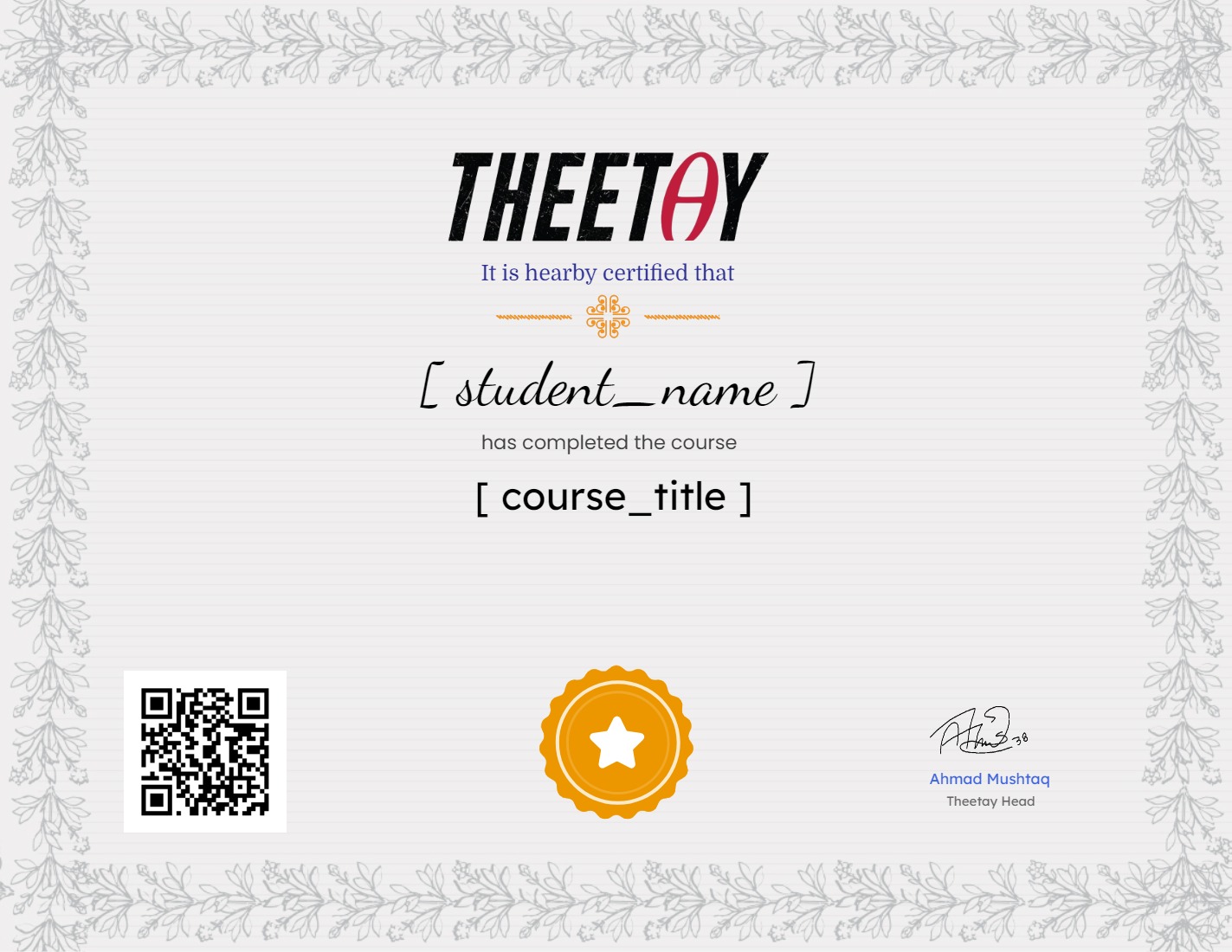MongoDB – The Complete Developer’s Guide 2023

About Course
Learn MongoDB, the popular NoSQL database, with this comprehensive online course. This free course, available on Theetay, is offered by Udemy and covers everything from the basics to advanced concepts.
Master MongoDB, a highly sought-after skill for web, mobile, and data science developers. This course is designed for beginners and covers all the essentials, including:
- Installation and usage of MongoDB locally and in the cloud (MongoDB Atlas)
- CRUD operations on MongoDB databases
- Efficient data filtering techniques
- Working with the Mongo Shell and drivers (e.g., Node.js driver)
- Performance optimization using indexes
- The powerful Aggregation Framework in MongoDB
- Replica sets and sharding
- Utilizing MongoDB Atlas, the cloud solution
- Working with the serverless platform (Stitch)
- And much more!
This hands-on course provides practical examples and use cases, giving you the knowledge to confidently implement MongoDB in your projects. It doesn’t matter which programming language you use; this course teaches a universal approach to interacting with MongoDB that is language-agnostic.
This free course is perfect for:
- Beginners with no prior MongoDB or database experience
- Individuals with some database or MongoDB experience looking for a deeper understanding
- Web, mobile, or desktop app developers considering using MongoDB
- Teams looking to adopt or leverage MongoDB
- Those primarily working with SQL-based databases who want to explore the most popular NoSQL alternative
This course is NOT for individuals seeking a guide on administrating MongoDB servers. The focus is on the commands and queries you write, not server administration. However, it includes a detailed explanation of deploying a ready-to-use cloud MongoDB solution following best practices.
Enroll now and take advantage of this completely free MongoDB course, brought to you by Theetay, featuring courses from top platforms like Udemy, Udacity, Coursera, MasterClass, NearPeer, and more.
What Will You Learn?
- Learn what document databases are and how data is organized with MongoDB
- Learn how to perform CRUD operations with MongoDB
- Don't stop at the basics - learn all about writing complex MongoDB queries, in-depth and with practical examples!
- Write efficient and well-performing queries to fetch data in the format you need it
- Use all features MongoDB offers you to work with data efficiently
Course Content
Introduction
-
A Message from the Professor
-
Introduction
02:07 -
What is MongoDB_
05:36 -
The Key MongoDB Characteristics (and how they differ from SQL Databases)
02:55 -
Understanding the MongoDB Ecosystem
04:19 -
General Setup Instructions & Installing MongoDB on macOS
16:52 -
Installing MongoDB on Windows
08:10 -
Installing the MongoDB Shell
05:10 -
Time To Get Started!
05:37 -
Shell vs Drivers
03:29 -
MongoDB + Clients_ The Big Picture
02:58 -
Course Outline
04:38 -
How To Get The Most Out Of The Course
02:30 -
Course Material Download Link
00:00
Understanding the Basics & CRUD Operations
-
Module Introduction
01:30 -
Understanding Databases
03:47 -
The Shell & MongoDB Drivers for Different Languages
02:40 -
Creating Databases & Collections
03:16 -
Understanding JSON Data
04:05 -
Comparing JSON & BSON
05:23 -
Create
05:37 -
Finding
07:47 -
Understanding _insertMany()_
01:48 -
Diving Deeper Into Finding Data
03:55 -
_update_ vs _updateMany()_
04:41 -
Understanding _find()_ & the Cursor Object
07:30 -
Understanding Projection
03:38 -
Embedded Documents & Arrays – The Theory
01:56 -
Working with Embedded Documents
02:28 -
Working with Arrays
01:43 -
Accessing Structured Data
04:39 -
Wrap Up
02:47
Schemas & Relations_ How to Structure Documents
-
Module Introduction
02:12 -
Why Do We Use Schemas_
03:57 -
Structuring Documents
07:43 -
Data Types – An Overview
06:23 -
Data Types in Action
12:15 -
How to Derive your Data Structure – Requirements
05:07 -
Understanding Relations
02:58 -
One To One Relations – Embedded
06:20 -
One To One – Using References
04:54 -
One To Many – Embedded
05:07 -
One To Many – Using References
04:04 -
Many To Many – Embedded
07:17 -
Many To Many – Using References
05:25 -
Summarizing Relations
02:01 -
Using _lookUp()_ for Merging Reference Relations
04:36 -
Planning the Example Exercise
06:56 -
Implementing the Example Exercise
04:16 -
Understanding Schema Validation
02:57 -
Adding Collection Document Validation
09:07 -
Changing the Validation Action
03:43 -
Wrap Up
04:08
Exploring The Shell & The Server
-
Module Introduction
01:01 -
Finding Available Options
02:15 -
Setting _dbpath_ & _logpath_
04:41 -
Exploring the MongoDB Options
02:00 -
MongoDB as a Background Service
03:09 -
Using a Config File
03:02 -
Shell Options & Help
04:13
Using the MongoDB Compass to Explore Data Visually
-
Module Introduction
00:50 -
Exploring the MongoDB Compass
05:50
Diving Into Create Operations
-
Module Introduction
01:12 -
Creating Documents – An Overview
01:47 -
Understanding _insert()_ Methods
06:10 -
Working with Ordered Inserts
07:47 -
Understanding the _writeConcern_
05:44 -
The _writeConcern_ in Practice
04:09 -
What is Atomicity_
02:39 -
Importing Data
03:37 -
Wrap Up
02:38
Read Operations – A Closer Look
-
Module Introduction
01:40 -
Methods
02:54 -
Operators – An Overview
03:02 -
Query Selectors & Projection Operators
01:16 -
Understanding _findOne()_ & _find()_
04:32 -
Working with Comparison Operators
05:20 -
Querying Embedded Fields & Arrays
04:52 -
Diving Into Element Operators
05:30 -
Diving Deeper Into Querying Arrays
04:09 -
Understanding Cursors
02:48 -
Applying Cursors
06:02 -
Sorting Cursor Results
03:09 -
Skipping & Limiting Cursor Results
03:31 -
Using Projection to Shape our Results
04:02 -
Using Projection in Arrays
05:12
Update Operations
-
Module Introduction
01:01 -
Incrementing & Decrementing Values
03:33 -
Using _$min_
03:15 -
Getting Rid of Fields
02:04 -
Renaming Fields
01:20 -
Understanding _upsert()_
04:01 -
Updating Matched Array Elements
06:56 -
Updating All Array Elements
06:27 -
Finding & Updating Specific Fields
05:35 -
Adding Elements to Arrays
04:46 -
Removing Elements from Arrays
02:34 -
Wrap Up
01:39
Understanding Delete Operations
-
Module Introduction
00:31 -
Understanding _deleteOne()_ & _deleteMany()_
04:08 -
Deleting All Entries in a Collection
02:00
Working with Indexes
-
Module Introduction
01:20 -
What Are Indexes & Why Do We Use Them_
04:18 -
Adding a Single Field Index
08:06 -
Understanding Index Restrictions
02:51 -
Creating Compound Indexes
07:14 -
Using Indexes for Sorting
02:25 -
Understanding the Default Index
00:59 -
Configuring Indexes
02:28 -
Understanding Partial Filters
06:07 -
Applying the Partial Index
03:37 -
Understanding the Time-To-Live (TTL) Index
03:56 -
Query Diagnosis & Query Planning
02:10 -
Understanding Covered Queries
03:34 -
How MongoDB Rejects a Plan
07:37 -
Using Multi-Key Indexes
08:16 -
Understanding Text Indexes
06:09 -
Text Indexes & Sorting
02:21 -
Creating Combined Text Indexes
02:54 -
Using Text Indexes to Exclude Words
00:54 -
Setting the Default Language & Using Weights
06:32 -
Building Indexes
07:40 -
Wrap Up
02:24
Working with Geospatial Data
-
Module Introduction
00:53 -
Adding GeoJSON Data
04:51 -
Running Geo Queries
03:22 -
Adding a Geospatial Index to Track the Distance
02:52 -
Adding Additional Locations
03:34 -
Finding Places Inside a Certain Area
06:22 -
Finding Out If a User Is Inside a Specific Area
05:27 -
Finding Places Within a Certain Radius
05:38 -
Wrap Up
01:40
Understanding the Aggregation Framework
-
Module Introduction
01:34 -
What is the Aggregation Framework_
02:00 -
Getting Started with the Aggregation Pipeline
01:21 -
Using the Aggregation Framework
03:12 -
Understanding the Group Stage
05:56 -
Diving Deeper Into the Group Stage
03:12 -
Turning the Location Into a geoJSON Object
07:59 -
Transforming the Birthdate
03:48 -
Using Shortcuts for Transformations
01:25 -
Pushing Elements Into Newly Created Arrays
04:03 -
Eliminating Duplicate Values
00:50 -
Using Projection with Arrays
03:03 -
Getting the Length of an Array
01:12 -
Applying Multiple Operations to our Array
07:31 -
Diving Into Additional Stages
07:29 -
Writing Pipeline Results Into a New Collection
01:47 -
Wrap Up
02:41
Working with Numeric Data
-
Module Introduction
00:54 -
Number Types – An Overview
06:28 -
Understanding Programming Language Defaults
03:33 -
Working with int32
05:17 -
Working with int64
06:32 -
Doing Maths with Floats int32s & int64s
06:57 -
What’s Wrong with Normal Doubles_
04:20 -
Working with Decimal 128bit
04:14 -
Wrap Up
01:40
MongoDB & Security
-
Module Introduction
04:23 -
Understanding Role Based Access Control
06:48 -
Roles – Examples
02:13 -
Creating a User
05:50 -
Built-In Roles – An Overview
05:40 -
Assigning Roles to Users & Databases
04:48 -
Updating & Extending Roles to Other Databases
05:06 -
Adding SSL Transport Encryption
10:21 -
Encryption at REST
01:25 -
Wrap Up
03:21
Performance, Fault Tolerancy & Deployment
-
Module Introduction
01:52 -
What Influences Performance_
03:01 -
Understanding Capped Collections
05:05 -
What are Replica Sets_
04:36 -
Understanding Sharding
06:14 -
Deploying a MongoDB Server
02:25 -
Using MongoDB Atlas
09:17 -
Backups & Setting Alerts in MongoDB Atlas
01:27 -
Connecting to our Cluster
03:36 -
Wrap Up
01:58
Transactions
-
Module Introduction
01:04 -
What are Transactions_
02:03 -
A Typical Usecase
02:18 -
How Does a Transaction Work_
07:42
From Shell to Driver
-
Module Introduction
02:13 -
Splitting Work Between the Driver & the Shell
02:06 -
Preparing our Project
04:49 -
Installing Visual Studio Code
01:46 -
Installing the Node.js Driver
04:56 -
Connecting Node.js & the MongoDB Cluster
06:31 -
Storing Products in the Database
04:53 -
Storing the Price as 128bit Decimal
06:10 -
Fetching Data From the Database
06:23 -
Creating a More Realistic Setup
11:48 -
Getting a Single Product
03:20 -
Editing & Deleting Products
07:28 -
Implementing Pagination
04:58 -
Adding an Index
01:27 -
Signing Users Up
07:03 -
Adding an Index to Make the Email Unique
01:13 -
Adding User Sign In
05:18 -
Wrap Up
01:11
Introducing Stitch
-
Module Introduction
01:42 -
What is Stitch_
07:23 -
Preparations
02:04 -
Start Using Stitch
04:33 -
Adding Stitch to our App & Initializing It
08:11 -
Adding Authentication
02:48 -
Sending Data Access Rules
03:58 -
Fetching & Converting Data
01:49 -
Deleting Products
03:02 -
Finding a Single Product
04:09 -
Adding Products
03:29 -
Updating Products
03:46 -
Switching to User Email & Password Authentication
01:54 -
Adding User Sign Up & Confirmation
06:32 -
Adding User Login
03:42 -
Rules & Real Users
01:48 -
Functions & Triggers
05:01 -
Wrap Up
00:56
Roundup
-
Course Roundup
03:05
Earn a certificate
Add this certificate to your resume to demonstrate your skills & increase your chances of getting noticed.

Student Ratings & Reviews


